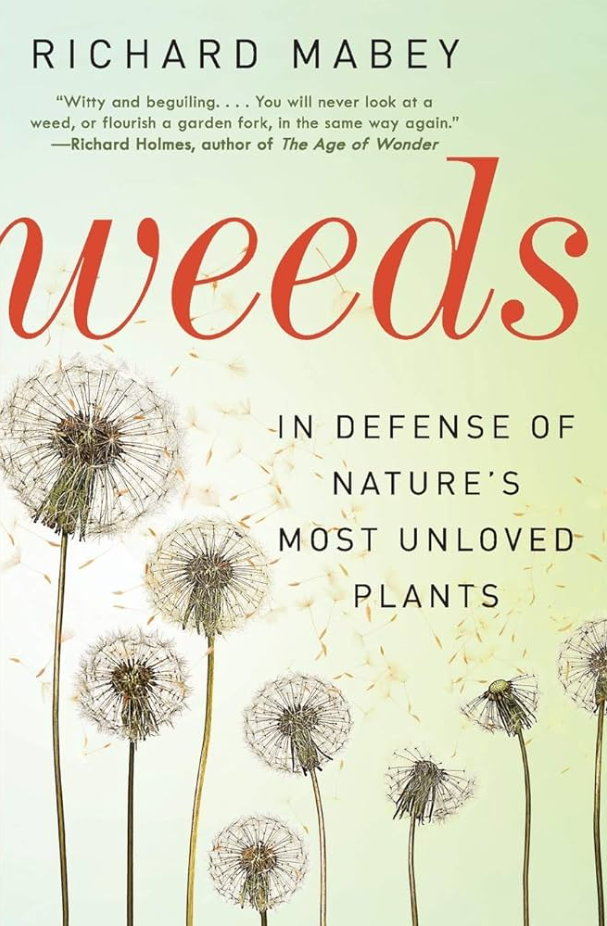Armchair Birding: Weeds: In Defense of Nature’s Most Unloved Plants, by Richard Mabey
~Anne Kilgannon
Why am I writing about weeds, for birders? And English weeds, no less? Because Mabey’s writing is captivating and his thinking profound and challenging and timely. Swap out “starlings” for “weeds” or any other introduced unwanted bird and you could have the same discussion Mabey initiates wherever you live. I see this book as an analogy for all kinds of issues concerning native and non-native species, the role of human interventions—or not—in questions of balance, survival, and coping with the impact of climate change. What belongs? What deserves our notice and protection? Even our affection and acceptance? Can we learn to love starlings? What if they turn out to be among our likely surviving and thriving species as the world heats and grows more erratic? As I ponder all these questions and more, I found, not answers per se, but an inspiring perspective as Mabey explores the lessons he has gleaned from his decades of work as a botanist. So I invite you to join me in that exploration.
First, Mabey is a great storyteller and he’s been on some adventures out of the ordinary. I’ve been a keen tourist in many places in England but I’ve never visited a tip—a garbage dump—to see what strange plants might find a niche there to thrive and spread. It’s just one of the places Mabey discovers where weeds, defined as plants you don’t want growing where you don’t want them, show up: attached to old shipping containers, sticking to rubbish, transplanted accidently from all over the world but still very much alive. Worldwide trade creates an opportunistic pathway for a wide dispersal of, say, Japanese knotweed, Himalayan balsam, New Zealand pigmyweed or South American parrot’s feather. It’s not just a modern phenomenon; Mabey traces many seemingly native-to-England plants back in time to plants brought over from the Mediterranean area during the Roman occupation and even before.
Even as we marvel at his depth of historical botanical knowledge, it begs the question of just what is a native plant? He’s the first to ask himself and challenge his readers to examine their own notions. Where to draw the line? One feels a discussion with Mabey about human immigration, as well as plants and the insects that tag along with them, would be eye-opening and broader than the usual border talk. As the climate rearranges migration patterns for trees, plants, birds and butterflies, non-native and invasive categories will be both more problematic and almost meaningless. “Survival of the fittest” may take on new layers of distinction. (And if we can’t even figure out what to do with plants and animals migrating and rooting themselves in new places, what will we all do as humans press against borders and confront walls everywhere?)
The other issue looming in any discussion of inconvenient plants, whatever their origin, is our ferocious chemical warfare against ones we don’t favor in our fields and gardens. Mabey writes, “Times are changing for weeds. They are at one and the same time more successful and more brutally attacked than at any time in history.” He compares the impact of a traditional technology—the hoe—with its result of favoring the survival of plants with deeper root systems with present-day ones that have evolved a resistance to our escalating dousing of herbicides and other concoctions and finds that we are creating “super” species and also devastating our insect and bird allies in the process. The inevitable results will be plants “whose biochemistry is unusual enough to be immune to the poison.” While keeping a wary eye on that development, Mabey reports that he also sees a backlash to that approach and an emerging new acceptance of plants formerly classed as weeds as a kind of rewilding movement. More people are exploring foraging opportunities, something Mabey pioneered in England for decades. The discovery of “wild foods” is bringing a new respect for dandelions, chickweed and nettles, to name the most accessible.
He finds other signs of hope and re-assessment. If a plant shows up in your salad bowl or creates a lovely effect in your garden or you discover how it supports crucial pollinators or birds or other wildlife… you might welcome it without worrying about its pedigree. Or, you find you can manage it so it doesn’t take over your whole garden or cropland, and you might give it a place to thrive. Mabey asks us to slow down and examine the possibilities, to create, perhaps, a different framework for determining what is a threat and what might be an opportunity. Starlings might deserve a second look; at least we’ve stopped killing all our hawks, eagles and owls. This book offers a wealth of timely ideas to ponder and a great romp through the byways of the countryside and back alleys of Great Britain. Take a look!








